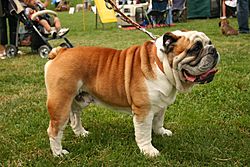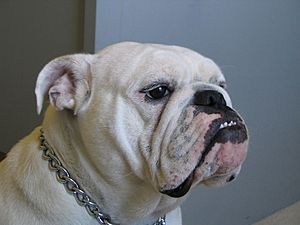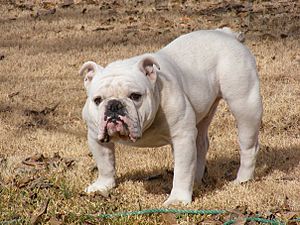Bulldog facts for kids
The Bulldog, known as the British Bulldog or English Bulldog, is a medium-size breed of dog that originated in England.
Description
Appearance
The Bulldog is a breed with characteristically wide head and shoulders along with a pronounced mandibular prognathism. There are generally thick folds of skin on a Bulldog's brow; round, black, wide-set eyes; a short muzzle with characteristic folds called a rope or nose roll above the nose; hanging skin under the neck; drooping lips and pointed teeth, and an underbite with an upturned jaw. The coat is short, flat, and sleek, with colours of red, fawn, white, brindle, and piebald.
In the United Kingdom, the breed standards are 55 lb (25 kg) for a male and 50 lb (23 kg) for a female. In the United States, a typical mature male weighs 50 lb (23 kg), while mature females weigh about 40 lb (18 kg). The BCA recommends the average weight of a bulldog to be 40–50 lb (18–23 kg).
Bulldogs are one of the few breeds whose tail is naturally short and either straight or screwed and thus is not cut or docked as with some other breeds. A straight tail is a more desirable tail according to the breed standard set forth by the BCA if it is facing downward, not upwards.
Temperament
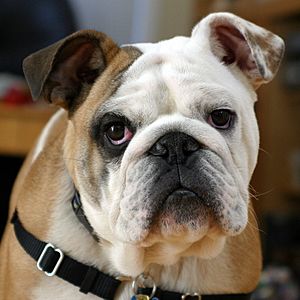
According to the American Kennel Club (AKC), a Bulldog's disposition should be "equable and kind, resolute, and courageous (not vicious or aggressive), and demeanor should be pacific and dignified. These attributes should be countenanced by the expression and behavior".
Breeders have worked to reduce/remove aggression from these dogs. Most have a friendly, patient, but stuborn nature. Bulldogs are recognized as excellent family pets because of their tendency to form strong bonds with children.
Generally, Bulldogs are known for getting along well with children, other dogs, and pets.
History
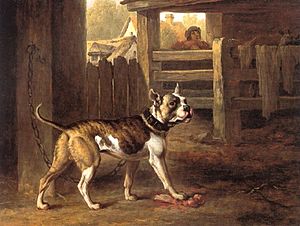
The term "Bulldog" was first mentioned in literature around 1500, the oldest spelling of the word being Bondogge and Bolddogge. The first reference to the word with the modern spelling is dated 1631 or 1632 in a letter by a man named Preswick Eaton where he writes: "procuer mee two good Bulldogs, and let them be sent by ye first shipp". In 1666, English scientist Christopher Merret applied: "Canis pugnax, a Butchers Bull or Bear Dog", as an entry in his Pinax Rerum Naturalium Britannicarum.
The designation "bull" was applied because of the dog's use in the sport of bull baiting. This entailed the setting of dogs (after placing wagers on each dog) onto a tethered bull. The dog that grabbed the bull by the nose and pinned it to the ground would be the victor. Bull-baiting, along with bear-baiting, reached the peak of its popularity in England in the early 1800s until they were both made illegal by the Cruelty to Animals Act 1835. This amended the existing legislation to protect animals from mistreatment and included (as "cattle") snakes, dogs, owls, and donkeys, so that bull and bear-baiting as well as cockfighting became prohibited. Therefore, the Old English Bulldog had outlived its usefulness in England as a sporting animal and its active or "working" days were numbered. However, emigrants did have a use for such dogs in the New World.
In mid-17th century New York, Bulldogs were used as a part of a citywide roundup effort led by Governor Richard Nicolls. Because cornering and leading wild bulls were dangerous, Bulldogs were trained to seize a bull by its nose long enough for a rope to be secured around its neck. Bulldogs as pets were continually promoted by dog dealer Bill George.
Despite slow maturation so that growing up is rarely achieved by two and a half years, Bulldogs' lives are relatively short. At five to six years of age they start to show signs of aging.
Though today's Bulldog looks tough, he cannot perform the job he was originally created for as he cannot withstand the rigors of running and being thrown by a bull, and also cannot grip with such a short muzzle. Although not as physically capable as their ancestors, decreased levels of aggression associated with modern bulldogs have resulted in far calmer temperament while remaining physically capable guards and companions.
The oldest single breed specialty club is The Bulldog Club (England), which was formed in 1878. Members of this club met frequently at the Blue Post pub on Oxford Street in London. There they wrote the first standard of perfection for the breed. In 1894 the two top Bulldogs, King Orry and Dockleaf, competed in a contest to see which dog could walk 20 miles (32 km). King Orry was reminiscent of the original Bulldogs, lighter boned and very athletic. Dockleaf was smaller and heavier set, more like modern Bulldogs. King Orry was declared the winner that year, finishing the 20-mile (32 km) walk while Dockleaf collapsed. The Bulldog was officially recognized by the American Kennel Club in 1886.
At the turn of the 20th century, Ch. Rodney Stone became the first Bulldog to command a price of $5,000 when he was bought by controversial Irish American political figure Richard Croker.
Health
Like all dogs, Bulldogs require daily exercise. If not properly exercised it is possible for a Bulldog to become overweight, which could lead to heart and lung problems, as well as stress on the joints.
Bulldogs have very small nasal cavities and thus have great difficulty keeping their bodies cool. Bulldogs are very sensitive to heat. Extra caution should be practiced in warmer climates and during summer months. Bulldogs must be given plenty of shade and water, and must be kept out of standing heat. Air conditioning and good ventilation are required to keep them healthy and safe. Bulldogs actually do most of their sweating through the pads on their feet and accordingly enjoy cool floors. Like all brachycephalic, or "short faced", breeds, Bulldogs can easily become overheated and even die from hyperthermia.
Bulldog owners can keep these issues under control by staying aware and protecting their Bulldog(s) from these unsafe conditions.
They can be heavy breathers, and they tend to be loud snorers.
Bulldogs have a genetic predisposition to a condition called cherry eye. It occurs when the tear gland in the eye becomes swollen and red and covers part of the eye. Surgery is required to treat a cherry eye. The symptoms appear in pets under the age of two.
Related Pages
See also
 In Spanish: Bulldog para niños
In Spanish: Bulldog para niños


